Whether unplanned or part of scheduled maintenance, electricians need to connect low-voltage power supply cables…
What you can do if you hit an electrical cable when drilling in a wall?
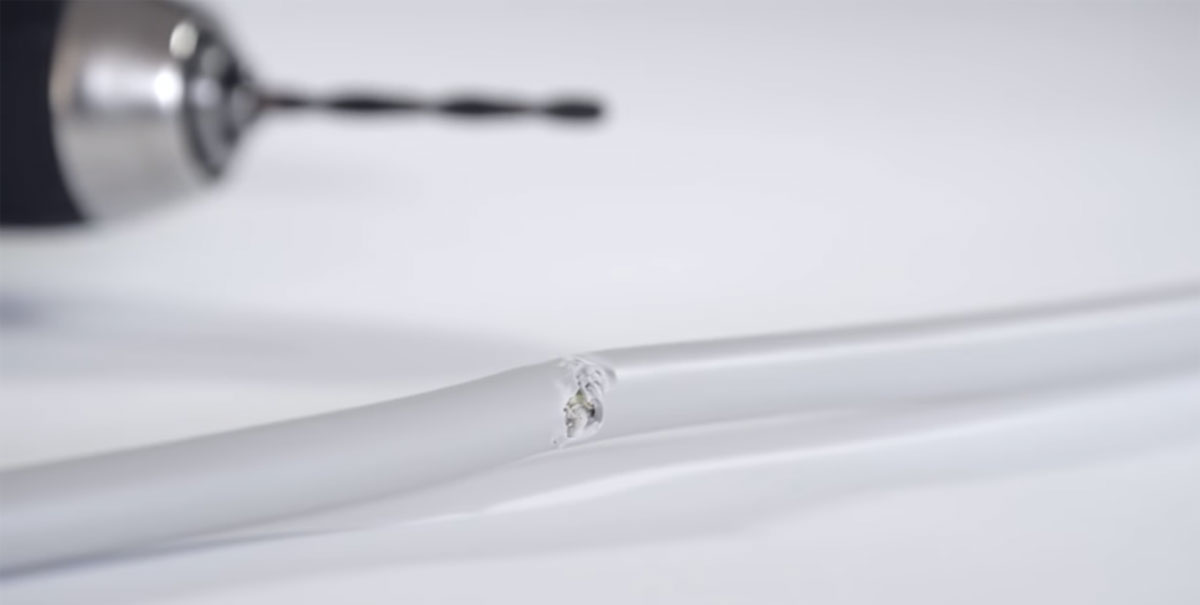
Damage to electrical wiring from drilling into walls is a surprisingly frequent phenomenon – especially when buildings are being renovated. Not only do the lights go out, but you usually blow a fuse as well. With a bit of luck, you might only have to repair the cable sheath. But if you damaged or severed a wire, just using a terminal strip, insulation tape and some silicone sealant are not recommended – you need some professional kit!
Please note: In general, electrical power cables in the wall or cavities most likely run vertically and horizontally from switches and sockets. If you suspect that an electric cable has been hit, it is absolutely necessary to repair it. You should immediately ensure that the power is switched off before touching anything. In the worst case, if the protective earth conductor has been damaged you otherwise run the risk of a fatal electric shock.
The alternative to the classic flush mount junction box:
LVRK-L, for a quick and safe repair
HellermannTyton‘s answer to the question how best to repair an electric cable that has been damaged is the LVRK-L Cable Repair Set for low-voltage wires. The handy pack contains everything you need to safely repair electrical wires that have been hit by a drill or severed by cutters or a blade. It’s a space-saving solution, too. There’s no need to pull new cables or channel out a large cavity to install a flush mount junction box.
Compared to the predecessor model (LVRK), the new kit includes longer 30mm crimp connectors. Compared to the shorter connectors, these are easier to process because two crimps are now possible instead of just one. In addition, the new connectors are suitable not only for flexible cores (multi-core), but also for rigid cores.
The most important advantages at a glance:
- Easy to process: The connectors allow two crimps, i.e. one crush per wire. The long contact surface also ensures a particularly firm hold.
- Versatile use: With a length of 30 mm each, the connectors are suitable for both multicore and rigid conductors. Ideal for repairing NYM cables and many other applications.
- The all-in-one solution: shrink tubing, crimp connectors and cable ties are usually only available in large quantities. Instead of stocking up unnecessarily and assembling the required products yourself, a single LRVK-L set is sufficient to repair a drilled cable.
A further benefit: To use a flush-mounted box, a correspondingly large recess is required in the wall. A cable repair with the LVRK-L-Kit, on the other hand, is much more space-saving and causes less wall work – and thus less dirt.
How to apply the Cable Repair Kit:
This video shows how easy it is to use the Cable Repair Kit. You can see the predecessor model LVRK (with the shorter crimp connectors). The handling with the new LVRK-L set is almost identical – with the difference that thanks to the longer connectors now two crimps are possible.
The cable repair set includes:
- a 200 mm an adhesive-lined heat shrink tube,
- five crimp butt connectors with heat shrinking insulation for 1.5 mm2 – 2.5 mm2 wire cross-sections
- plus four heat-stabilised T-series cable ties with their unique open head and pre-locking function for easy handling.
Where do you get the cable repair kit from? Ask your wholesaler or contact HellermannTyton sales directly.
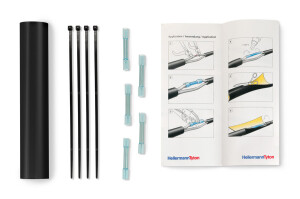
How to perfectly repair damaged electrical wires using the LVRK-L set:
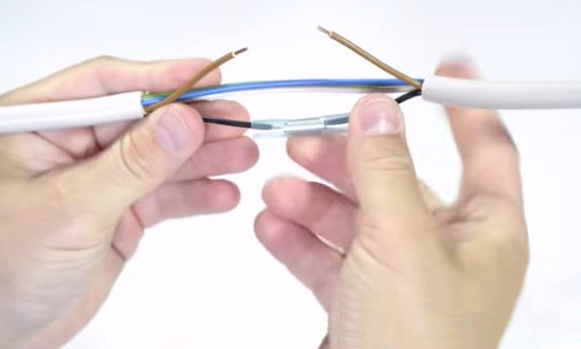 1. Observe all precautionary measures! Only after ensuring that the power is really off, remove the cable sheath from the affected area and separate the wires to expose the damaged section.
1. Observe all precautionary measures! Only after ensuring that the power is really off, remove the cable sheath from the affected area and separate the wires to expose the damaged section.
Then insert the required number of crimp butt connectors and heat them to 150 °C so that the heat shrink insulation fits snugly around the connection.
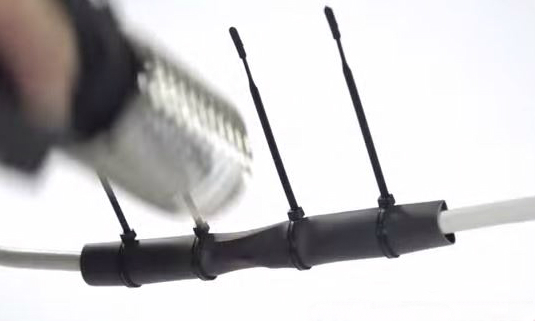 2. After that, slip the pre-slit heat shrink sleeve over the repaired section and fix it in place with the heat-stabilsed Q-cable ties supplied. Heat the sleeve from the middle outwards until the adhesive and the sleeve completely seal the spot. The adhesive also prevents moisture from entering.
2. After that, slip the pre-slit heat shrink sleeve over the repaired section and fix it in place with the heat-stabilsed Q-cable ties supplied. Heat the sleeve from the middle outwards until the adhesive and the sleeve completely seal the spot. The adhesive also prevents moisture from entering.
You can tighten and cut off the excess cable tie when finished.
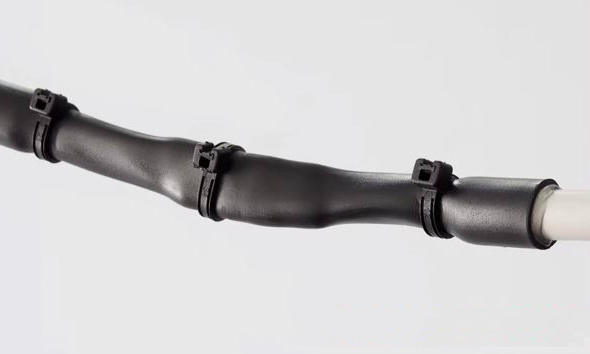 3. As soon as everything has cooled down, the power can go back on – fast, safe, durable and cost-effective. You can plaster the repaired cable in place and off you go! No flush mount junction boxes, no fuss and minimal mess.
3. As soon as everything has cooled down, the power can go back on – fast, safe, durable and cost-effective. You can plaster the repaired cable in place and off you go! No flush mount junction boxes, no fuss and minimal mess.
Apart from a crimper and a hot air gun you don’t need any special tools.
Will the insurance pay for repair to my tapped power cable? As a rule, liability insurance pays the damage. However, in the case of negligent action, exceptions may occur. A record of where the wiring is installed or a device for detecting wires and pipes can help you prevent mishaps occurring. However, don’t rely on it 100 %. Only drill where really necessary and exercise extreme caution.
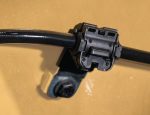 Are you familiar with the Ratchet P-Clamp – our new cable clamp which allows you to separate the cable routing and fixing tasks? Find out more here “Flexible, custom-fit cable routing: The new Ratchet P-Clamp cable clamp”
Are you familiar with the Ratchet P-Clamp – our new cable clamp which allows you to separate the cable routing and fixing tasks? Find out more here “Flexible, custom-fit cable routing: The new Ratchet P-Clamp cable clamp”
Do you need re-openable cable ties for temporary fixing? Read more about our “Releasable re-usable cable ties”
#3020

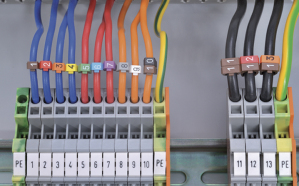



Thanks for sharing the valueable information about.
What you can do if you hit an electrical cable when drilling in a wall. Really it’s a great blog.
This may happen to everyone which I found your article interesting, I never thought of what’s next if this happens to me, which is I’m glad I read your post, Thank you this is so informational!
Putting a insert in our bedroom, we went to drill a hole in the wall and discovered wires, we stopped, what do you suggest we do? We’re needing to go all the way through. Stupid question, I know. Help!!!
Hi Rozanne, I’m not an electrician. I’d try drilling in another position. If there are cables too, I would not drill and find another solution for your problem, best regards Nico
We couldn’t have got much clearer information about the solution if hitting an electric cable during drilling a wall. Thanks for so much details. Great article and I would share it as much as possible to spread this. One must check this viperelectrical.co.nz it gives us more info on this topic.
This evening I installed a water hose reel on the outside wall and the lower left screw on the square hose holder must have nicked a power line tripping a GCFI circuit but not the breaker.
Now, it’s dark and late and I’m concerned my home will start on fire.
I’ll have to consider cutting a 6”X6” square gently on the outside fascia to repair this error.
Any suggestions? Joseph from New Mexico 87532
Hi, Joseph. Safety first. Please always contact a professional electrician in such cases. At best, turn off the central switch in your panel. Good luck, Nico
Beautiful illustration on the what you can do if you hit an electrical cable when drilling in the wall. So, happy that I found your blog. Thank you for posting this useful information over here. Appreciative content. I love reading this article. I would surely come again in this site to learn more.
Great article, but how do I get the wire down to a place where I can repair it without cutting a big hole in the wall?! I was drilling about 6 inches from a wall outlet. If I remove that outlet will there likely be enough loose/excess wire to stretch it down and out the outlet hole for repair? I didn’t cut all way through the wire, just flipped the breaker and after reset the GFI outlet works again fine, but the light is flashing red. Thanks.
Hi SDI, Safety first. Please always contact a professional electrician in such cases, especially if the light is flashing red. At best, turn off the central switch in your panel. Good luck, Nico
I think I nicked a wire since the circuit breaker tripped. For some reason, my stud finder that also detects electrical wires does not signal that there is anything electrical in that location. the power is back on but I am concerned there is a possible fire danger.
any help is appreciated
Dear carlos. Safety first. Please always contact a professional electrician in such cases.
Good luck, Nico
Good. Thank you for posting this useful information over here.